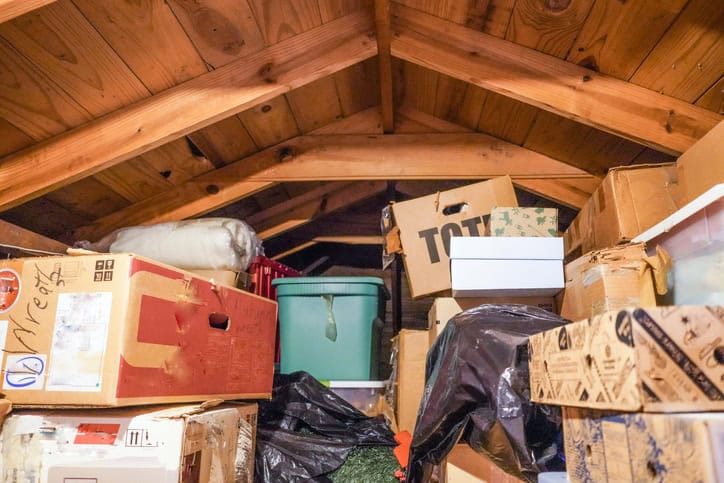
Even if you spend only a few short minutes scrolling on Instagram or Facebook, you will see many images of professional organizers talking about decluttering. There are also gorgeous photos featuring views of minimally decorated homes. While decluttering and minimalism are often praised as the keys to a peaceful and organized life, there is also a lesser-known but significant challenge: disposaphobia. Disposaphobia is the fear of throwing things away, even items that may seem insignificant or useless to others. This phobia can have a profound impact on an individual’s daily life, relationships, and mental well-being.
The Nature of Disposaphobia
Disposaphobia, also known as disposophobia or hoarding disorder, goes beyond mere reluctance or sentimentality attached to possessions. It is an anxiety disorder characterized by an overwhelming fear of discarding items, leading to excessive accumulation and clutter. People with disposaphobia often experience distress at the thought of parting with their possessions, regardless of their practical value. Since I am a certified professional organizer in chronic disorganization and not a therapist, I work with people challenged by disposaphobia (or hoarding) as it relates to the things they keep. The person with this challenge and I work together to reduce the number of things they keep and to create better functionality in their home.
Causes and Triggers
Like many phobias, disposaphobia can stem from various factors. Below are some of the factors which may contribute to this challenging disorder. If I am contacted by a therapist to work with someone with disposophobia, they will (with their patient’s permission) share one or more of these underlying causes or triggers.
Traumatic Events
Past experiences such as loss, deprivation, or significant life changes can trigger disposaphobia. For example, someone who grew up in poverty may develop a fear of discarding items due to a fear of scarcity. Like those who lived through the Great Depression.
Anxiety and Control
Disposaphobia may show up as a coping mechanism for anxiety or a need for control. The act of holding onto objects provides a sense of security and comfort for some individuals.
Perfectionism
Perfectionists may struggle with disposaphobia as they fear making the wrong decision about what to keep or discard. The fear of regretting a disposal decision can be paralyzing. The person can spend countless hours reviewing the pros and cons before arriving at a decision. Even then, they may not be willing to commit to it.
Attachment and Sentimentality
Emotional attachment to possessions, even those with little practical value, can contribute to disposaphobia. Each item may hold memories or emotional significance, making it challenging to let go.
Effects on Daily Life
Disposaphobia can significantly impact an individual’s daily life in several ways:
Clutter and Disorganization
Accumulated items can clutter living spaces, making it difficult to navigate or find essential items. This clutter can lead to stress and a sense of overwhelm. The person may have trouble getting places on time because they temporarily ‘lost’ something in one of the piles around their home.
Social and Interpersonal Challenges
Disposaphobia can strain relationships, as family members or roommates may struggle to understand or accommodate the excessive clutter. They are often fearful of letting people into their homes because they are embarrassed by the way it looks. This fear may even extend to repairmen.
Financial Burden
Hoarding can lead to financial strain, as individuals may continue to acquire items they don’t need or use, leading to wasted money and space. People also waste money on buying things they know they already own but can’t find because of the disorganization.
Health and Safety Risks
Extreme cases of disposaphobia can pose health and safety risks, such as fire hazards, pest infestations, and unsanitary living conditions. Elderly people are prone to falls and may become trapped in an overfull home.
Coping Strategies and Treatment
Overcoming disposaphobia often requires professional intervention and a combination of therapeutic approaches. As a professional organizer, I do not provide therapy. I have, however, worked with therapists as they provide treatment for the person in their office, and I provide the organizational strategies in the home.
Cognitive-Behavioral Therapy (CBT)
CBT helps individuals identify and challenge irrational beliefs and behaviors related to hoarding. It aims to change thought patterns and develop healthier coping strategies.
Exposure Therapy
Gradual exposure to discarding items can help desensitize individuals to the anxiety associated with letting go. Therapists work with clients to practice decision-making and decluttering in a controlled environment.
Support Groups
Joining a virtual organizing support group and/or working with professional organizers who specialize in hoarding disorder (like me) can provide valuable support and guidance throughout the recovery process.
Conclusion
Disposaphobia is a complex and challenging anxiety disorder that requires understanding, patience, and specialized treatment. By addressing the underlying causes and learning healthy coping strategies, individuals with disposaphobia can regain control over their possessions and improve their quality of life. It’s essential to approach disposaphobia with compassion and empathy, recognizing that overcoming this fear is a journey that takes time and effort.
If this is you, please contact me to schedule a free 30-minute phone consultation. Send me an email to schedule this free call. DNQSOLUTIONS@GMAIL.COM
Diane N. Quintana is an ICD Master Trainer, Certified Professional Organizer in Chronic Disorganization, Certified Professional Organizer, owner of DNQ Solutions, LLC and co-owner of Release Repurpose Reorganize LLC based in Atlanta, Georgia. She specializes in residential and home-office organizing and in working with people challenged by ADHD, Hoarding and chronic disorganization.


I liked learning about the term Disposaphobia, It is a good way to introduce hoarding disorder into a conversation. Most people can relate to having a phobia. Understanding your clients is the most important step in working with them successfully. Thanks for listing many of the possible causes that people have for not being able to let go of things. It gets complicated quickly depending on how many causes are interrelated.
You’ve done a stellar job laying out the elements of the condition, the way it impacts someone’s life, and how it is treated. I’m curious about the origins of disposaphobia and wonder whether mental health professionals make any delineation between this issue as a phobia, per se, and hoarding disorder as it appears in the DSM-V. I suspect that if both are medical diagnoses, there’s a crossover in terms of treatment (as it appears) but perhaps more of a focus on a solution-orientation? Do you know? I’ve only heard the term a few times, and it makes me so curious.
I also wonder whether disposaphobia, entrenched in the concept of phobias, has a lesser stigma than hoarding disorder. All but the jerkiest of people accept the difficult nature of phobias and their impact on people’s lives; hoarding disorder is so much less understood by the general populace, even in the abstract. So, if these are truly the same conditions, and if positioning it entirely within the realm of phobias, is apt, there might be hope for lessening the stigma overall. One can hope! Thank you for this wise post.
Thank you, Julie. I’m not clear on where the crossover is between the Hoarding Disorder as defined in the DSMV and Disposaphobia. I agree that something with phobia attached to it is much gentler and easier to wrap one’s mind around than hoarding.
Thank you for this educational blog on disposaphobia. It is helpful to have enlightenment on the causes that make people reluctant to let stuff go. The more people understand that this is a mental illness and not a choice, the more likely the person can get the help they need.
I so agree, Jonda.
I had never heard of the term Disposaphobia, which is very interesting. Thank you for clarifying this challenge for individuals. I will be sharing it with my decluttering group.
Thank you, Sabrina. I had not heard this term until recently myself. I think it is a gentler sound than hoarding.
I wasn’t familiar with this term, but it’s very interesting.
Another way I can see perfectionism entering into the equation is when someone has some kind of collection, a set of books, for example. Even though they will probably never re-read the entire series, it feels like an all-or-nothing situation, where they either keep, give away or sell the entire set, not wanting to separate them.
I agree, Janet. Separating collections of things is truly heart-wrenching. How do you do that?
This is an excellent explanation, and I appreciate how sensitively you address it. Is disposophobia another term for hoarding disorder? And if so, is it being used more than hoarding disorder? Is disposophobia a preferred way to reference the disorder?
It’s so important to have a team approach in these situations. And also, being clear about your boundaries as a professional organizer (not a therapist) is also essential. Your clients are so fortunate to have your understanding, experience, and support.
Thank you, Linda. I think disposaphobia is a gentler expression and is beginning to be used to replace ‘hoarding’.
I’m so glad you are talking about this disorder, and being honest about how complex it can be. I think sometimes people think that those struggling with hoarding disorder are just stubborn or irrational. Empathy should be our first response, and care for the welfare of the individual. A team approach with a therapist and organizer is the best, as one can work on the causes and the other can help improve the “symptoms.” So thankful there are experts out there, investing time and money in equipping themselves to bring relief to those who are suffering and their families.
Thank you, Seana. It is such a complex disorder and so very misunderstood. The more empathy we can bring to it the better. Education regarding this disorder is key.